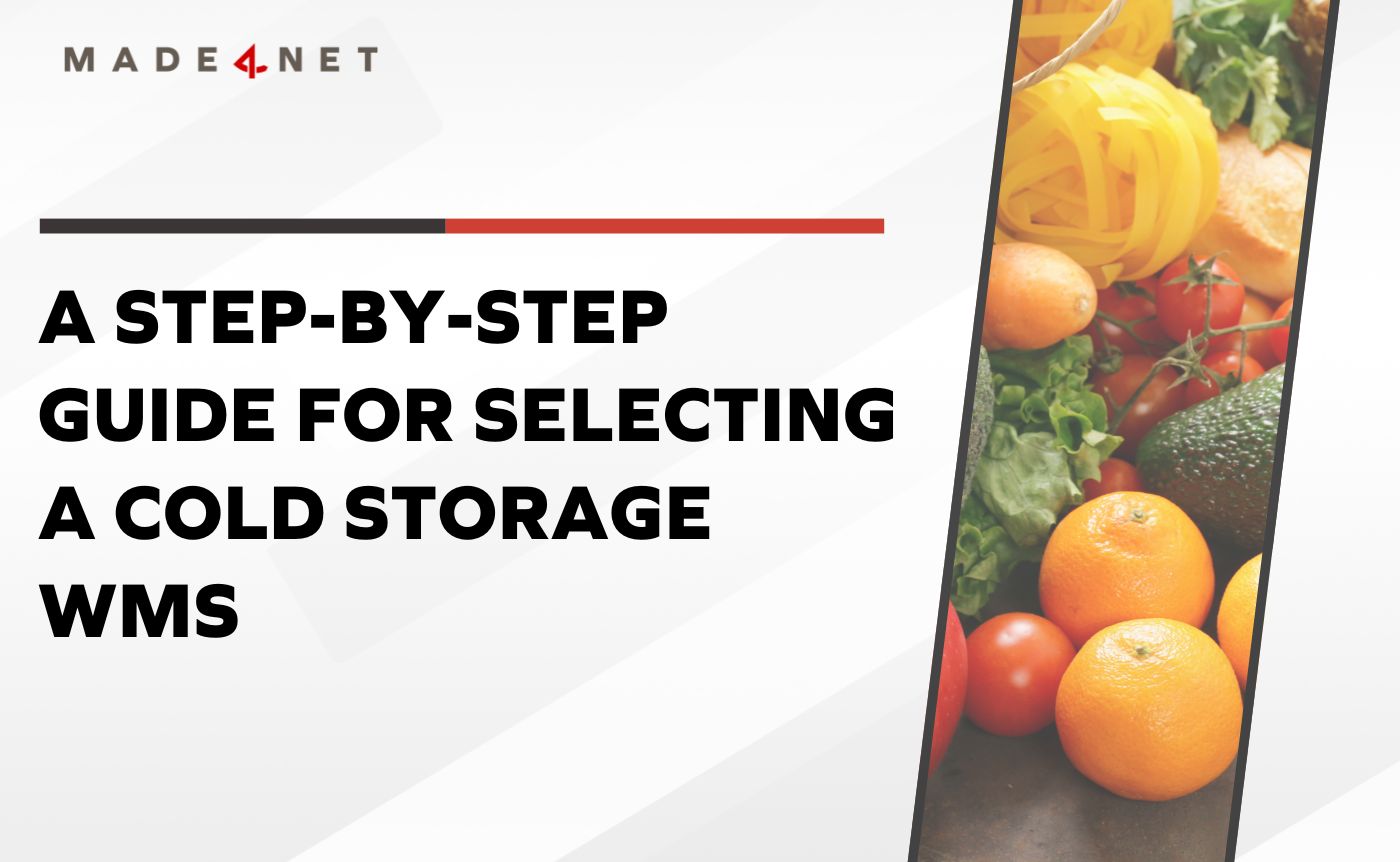
It’s important to select the right cold storage WMS or Food & Beverage WMS to help your operations unlock greater efficiency and productivity. The wrong decision can disrupt operations, while delays in choosing a solution may result in lost revenue and mounting inefficiencies. As an operator overseeing cold storage and fulfillment, you understand the unique demands of your warehouse better than anyone. Still, navigating the complexities of a cold storage WMS selection can be daunting.
Here’s a step-by-step guide to make it easy for you to evaluate potential cold storage WMS providers and choose the right option for your operational needs, including:
- Identify the Objectives in a Cold Storage WMS Investment
- Assess Your Team’s Capabilities and Cold Storage Needs
- Understand Integration Needs of Existing Software and Hardware
- Create a Cold Storage WMS Requirements List
- Identify Non-Standard Operations and Movements
- Collect Vendor Responses and Shortlist Partners
- Select the Cold Storage WMS and Plan for Implementation
Step 1: Identify the Objectives in a Cold Storage WMS Investment
The first step in selecting the best cold storage WMS for your business is to understand why you need a new system. Companies that require cold storage have distinct challenges in warehouse management that often require specialized solutions. Some common reasons why businesses like yours consider investing in cold storage WMS software include:
- Reducing Costs and Increasing Efficiency: You may want to leverage technology to cut down on workforce-related expenses, improve accuracy, and streamline warehouse processes.
- Solving Warehouse Issues: For example, manual errors in inventory management or inefficient order picking can be addressed with a software solution.
- Scaling for Growth: If your company is expanding, you might need a more robust system to manage increased demand and improve warehouse operations as you scale.
- Updating Outdated Systems: If your current system is not up to the task, or if you’re using an ERP that requires better integration with your warehouse operations, this is a signal that a new cold storage WMS may be necessary.
Each of these reasons will affect how you evaluate software options. For instance, a company focused on rapid growth may prioritize scalability, while one facing issues like inventory inaccuracies may need a solution focused on improving data tracking and accuracy.
Step 2: Assess Your Team’s Capabilities and Cold Storage Needs
Once you’ve identified your business goals, take a closer look at your team’s expertise. In food and beverage, for example, your staff’s ability to use new technology—like a cold storage WMS—effectively will play a major role in the success of your selection.
- Evaluate Your Workforce: Consider the existing knowledge and skills of your employees who will interact with the software. How comfortable are they with technology? Are there gaps in expertise that the software could help fill?
- Collaborate with Your IT Team: Your IT department should be involved early in the selection process to assess the software’s technical requirements and integrations. If your warehouse staff is not highly technical, look for a solution that is user-friendly and requires minimal training.
- Form a Cross-Functional Team: Assemble a team of representatives from different areas (warehouse staff, IT, logistics, procurement) to help review potential software solutions and ensure the system meets all departments’ needs.
Step 3: Understand Integration Needs of Existing Software and Hardware
Cold storage facilities typically use various systems and technologies, from enterprise resource planning (ERP) systems to barcode scanners and mobile devices. When choosing a new cold storage WMS, ensure that it integrates well with the tools you already use.
- Software Integration: Your new WMS software should seamlessly integrate with your existing ERP, accounting systems, and any other relevant software. Be upfront with vendors about the systems you rely on and ask them about their experience with similar integrations.
- Hardware Compatibility: Consider the mobile devices, barcode scanners, and other hardware currently in use in your warehouse. Choose a cold storage WMS that can support your existing hardware and any future upgrades you may require.
Some advanced cold storage WMS solutions can also offer support for modern hardware such as RF guns, mobile printers, and movable RF gates, all of which can boost operational efficiency.
Step 4: Create a Cold Storage WMS Requirements List
Before you start exploring different software options, make a detailed list of your cold storage facility’s requirements. This will help you evaluate how well each software solution meets your operational needs.
- Operational Tasks: Break down the various tasks in your cold storage facility, such as receiving, picking, packing, storage, inventory counting, and shipping. Identify how the software can support each task and improve efficiency.
- Scalability: If you’re expanding into new markets or growing your business, make sure the software can scale to meet future demands.
- Industry-Specific Needs: In the cold storage sector, there may be specific regulatory requirements, such as food safety standards, traceability, and temperature control. Ensure the software can handle these specialized needs.
- Supply Chain Connectivity: Consider how your cold storage WMS will interact with other areas of your business, such as procurement, suppliers, and customers. Choose a system that provides visibility and seamless communication across your supply chain.
Step 5: Identify Non-Standard Operations and Movements
Companies that require cold storage often deal with unique inventory challenges, such as perishable goods, batch tracking, and special handling for certain products. When evaluating cold storage WMS software, consider any non-standard requirements specific to your business.
- Returns and Lot Splitting: Some WMS solutions handle returns or splitting product lots differently, which could be crucial for your business if you deal with perishable goods or multi-item kits.
- Storage and Handling Needs: Certain products, like temperature-sensitive foods, require specialized storage and tracking. Look for software that can manage these unique storage conditions.
- Cross-Docking and Kitting: If you perform cross-docking or assembly of kits, ensure that the software can support these specialized processes.
Be sure to include these specialized needs in your requirements list to avoid overlooking them later.
Step 6: Collect Vendor Responses and Shortlist Partners
Once you’ve sent out your Request for Proposal (RFP), it’s time to review the responses from potential vendors. Keep the following tips in mind during this phase:
- Prioritize Functionality Over Price: While budget is important, choosing a cold storage WMS based solely on price can lead to missed opportunities. Focus on the features and functionalities that are crucial to your business operations. A cheaper solution might end up costing more in the long run if it doesn’t meet your needs.
- Check Vendor Experience: Look for vendors with experience working in the cold storage and who have a track record of satisfied customers. Ask for references and case studies to better understand how the software has performed in similar environments.
- Evaluate Total Cost of Ownership: Factor in all costs, including implementation, training, maintenance, and upgrades. A low upfront cost might be attractive, but consider the long-term investment in terms of your company’s growth and operational efficiency.
Step 7: Select the Cold Storage WMS and Plan for Implementation
After evaluating the cold storage WMS solutions based on your requirements and vendor responses, you’re ready to make a final selection. Keep in mind that successful implementation is just as important as choosing the right software.
- Training and Support: Choose a vendor that provides comprehensive training for your team and reliable ongoing support.
- Implementation Timeline: Make sure the implementation process is clearly outlined, with achievable milestones and timelines to minimize disruptions to your operations.
Once you’ve selected the right cold storage WMS, it’s essential to plan for integration and implementation carefully.
By following this structured approach, you can ensure that your cold storage WMS software supports your warehouse’s needs, improves operational efficiency, and positions your company for long-term success.
If you’re ready to explore your options or want to see how our solution could help streamline your warehouse operations, feel free to reach out for a demo or consultation. We’re here to help guide you through the selection process!
If you liked this article, you may also like the Top 6 Trends in Cold Food Warehousing and our tips for how to optimize a cold storage warehouse management system.


